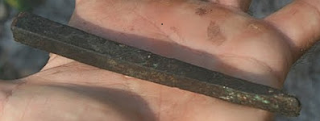Written by the TreasureGuide for the exclusive use of treasurebeachesreport.blogspot.com.
There are more than coins and gold and silver to be found on the 1715 Fleet wrecks. Besides the cargo there were all the necessities of daily life, and the nautical tools that were needed to keep a sailing ship in good working order. While those things might not be as glamorous or valuable as the queen's jewels they can be just as interesting and meaningful. |
| Artifacts Found On Treasure Coast Beaches. |
After finding information on the awl or fid that I showed yesterday, I decided to research a couple more iron beach finds a little more. They fall into the category of tools. They are shown above.
The larger one is not a chisel. That is what I called it for a while, but then one helpful reader informed me that it is not a chisel. It is a wedge.
A chisel removes material. A wedge separates things, like boards on a ship when they are going to be caulked.
I'm not sure if the smaller one is a wedge or chisel. I suspect it is a wedge too. If it is a chisel, it would be for wood - maybe stone.
Years ago I found the bronze one shown immediately below.
While doing research on nautical tools, I found a great resource. It is a master's thesis by Katie Custer, entitled Wrought Iron Hand Tools From The Underwater Archaeological Excavations of Colonial Port Royal, Jamaica, C. 1692.
The thesis is a very informative paper that you will probably want to browse. As the title suggests, it describes iron tool artifacts having to do with various trades active in Port Royal in the late 17th Century.
Not only does the thesis look at the artifacts, it also considers historical records and inventories. And of course there is a very useful reference list at the end.
Here is the link.
http://anthropology.tamu.edu/papers/Custer-MA2004.pdf
---
If you learn to interpret and appreciate iron artifacts, you will also want to be able to properly clean and conserve them.
One good reference is a PDF file entitled, The Care and Preservation of Historical Iron. This article was authored by Clara Deck, Senior Conservator of The Henry Ford Museum.
This one has a lot of good useful information too.
https://www.thehenryford.org/docs/default-source/default-document-library/the-henry-ford-iron-conservation.pdf?sfvrsn=2
---
 |
| Horsing Iron. |
Here is another web site you might want to look at. It shows a lot of antique nautical tools, including this horsing iron, which would be used for caulking.
http://www.ageofsail.net/aosbt.asp
---
I wanted to comment on the mystery item that I posted on 8/11. I received an number of excellent thoughts from helpful readers of this blog.
My opinion is that the item is likely more modern. A couple of knowledgeable and well-known shipwreck experts told Bob C. that the mystery item could be from a shipwreck. The item was found near other items that I believe are probably 1715 Fleet. I don't presume to be more knowledgeable than the well-known experts, who also had the advantage of seeing the item in person, but my opinion after viewing the picture, is that it is most likely more modern. My confidence level is 70 or 80 percent that it is modern. Of course I could be wrong.
The item might be easier to identify after it is cleaned.
Thanks to all who offered opinions.
---
There is no tropical activity of interest right now and the surf will remain calm for at least a few days.
Happy hunting,
TreasureGuide@comcast.net
